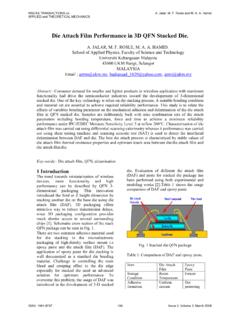Transcription of ANSOFT MAXWELL 2D/3D FIELD CALCULATOR - …
1 ANSOFT MAXWELL 2D/3D . FIELD CALCULATOR . -Examples- Introduction This manual is intended as an addendum to the on-line documentation regarding Post- processing in general and the FIELD CALCULATOR in particular. The FIELD CALCULATOR can be used for a variety of tasks, however its primary use is to extend the post-processing capabilities within MAXWELL beyond the calculation / plotting of the main FIELD quantities. The FIELD CALCULATOR makes it possible to operate with primary vector fields (such as H, B, J, etc) using vector algebra and calculus operations in a way that is both mathematically correct and meaningful from a MAXWELL 's equations perspective.
2 The FIELD CALCULATOR can also operate with geometry quantities for three basic purposes: - plot FIELD quantities (or derived quantities) onto geometric entities;. - perform integration (line, surface, volume) of quantities over specified geometric entities;. - export FIELD results in a user specified box or at a user specified set of locations (points). Another important feature of the ( FIELD ) CALCULATOR is that it can be fully macro driven. All operations that can be performed in the CALCULATOR have a corresponding image in one or more lines of macro language code.
3 Post-processing macros are widely used for repetitive post-processing operations, for support purposes and in cases where Optimetrics is used and post-processing macros provide some quantity required in the optimization / parameterization process. This document describes the mechanics of the tools as well as the softer side of it as well. So, apart from describing the structure of the interface this document will show examples of how to use the CALCULATOR to perform many of the post-processing operations encountered in practical, day to day engineering activity using MAXWELL .
4 Examples are grouped according to the type of solution. Keep in mind that most of the examples can be easily transposed into similar operations performed with solutions of different physical nature. Also most of the described examples have easy to find 2D versions. 1. Description of the interface The interface is shown in Fig. I1. It is structured such that it contains a stack which holds the quantity of interest in stack registers. A number of operations are intended to allow the user to manipulate the contents of the stack or change the order of quantities being hold in stack registers.
5 The description of the functionality of the stack manipulation buttons (and of the corresponding stack commands) is presented below: - Push repeats the contents of the top stack register so that after the operation the two top lines contain identical information;. - Pop deletes the last entry from the stack (deletes the top of the stack);. - RlDn (roll down) is a circular move that makes the contents of the stacks slide down one line with the bottom of the stack advancing to the top;. - RlUp (roll up) is a circular move that makes the contents of the stacks slide up one line with the top of the stack dropping to the bottom.
6 - Exch (exchange) produces an exchange between the contents of the two top stack registers;. - Clear clears the entire contents of all stack registers;. - Undo reverses the result of the most recent operation. Stack & stack registers Stack commands CALCULATOR buttons Fig. I1 FIELD CALCULATOR Interface The user should note that Undo operations could be nested up to the level where a basic quantity is obtained. The CALCULATOR buttons are organized in five categories as follows: - Input contains CALCULATOR buttons that allow the user to enter data in the stack; sub- categories contain solution vector fields (B, H, J, etc.)
7 , geometry(point, line surface, volume), scalar, vector or complex constants (depending on application) or even entire solutions. - General contains general CALCULATOR operations that can be performed with general . data (scalar, vector or complex), if the operation makes sense; for example if the top two entries on the stack are two vectors, one can perform the addition (+) but not multiplication (*);indeed, with vectors one can perform a dot product or a cross product but not a multiplication as it is possible with scalars.
8 - Scalar contains operations that can be performed on scalars; example of scalars are scalar constants, scalar fields, mathematical operations performed on vector which result in a scalar, components of vector fields (such as the X component of a vector FIELD ), etc. - Vector contains operations that can be performed on vectors only; example of such operations are cross product (of two vectors), div, curl, etc. - Output contains operations resulting in plots (2D / 3D), graphs, data export, data evaluation, etc. As a rule, CALCULATOR operations are allowed if they make sense from a mathematical point of view.
9 There are situations however where the contents of the top stack registers should be in a certain order for the operation to produce the expected result. The examples that follow will indicate the steps to be followed in order to obtain the desired result in a number of frequently encountered operations. The examples are grouped according to the type of solution (solver) used. They are typical medium/higher level post-processing task that can be encountered in current engineering practice. Throughout this manual it is assumed that the user has the basic skills of using the FIELD CALCULATOR for basic operations as explained in the on-line technical documentation and/or during ANSOFT basic training.
10 Note: The solution is always performed in the global (fixed) coordinate system. The plots of vector quantities are therefore related to the global coordinate system and will not change if a local coordinate system is defined with a different orientation from the global coordinate system. The same rule applies with the location of user defined geometry entities for post- processing purposes. For example the FIELD value at a user-specified location (point). doesn't change if the (local) coordinate system is moved around.







